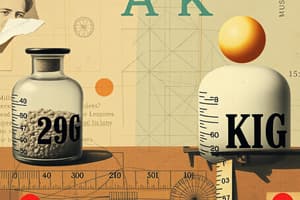Podcast
Questions and Answers
What defines mass, and how is it related to gravitational forces?
What defines mass, and how is it related to gravitational forces?
Mass measures the amount of matter in a body and quantifies its resistance to acceleration and interaction with gravitational forces.
How is momentum calculated, and what is its SI unit?
How is momentum calculated, and what is its SI unit?
Momentum is calculated as $p = mass \times velocity$, with the SI unit being kg·m/s.
What principle describes the relationship between total momentum before and after an interaction in a closed system?
What principle describes the relationship between total momentum before and after an interaction in a closed system?
In a closed system, total momentum before an interaction equals total momentum after.
Describe one example of how conservation of momentum is demonstrated in a real-world scenario.
Describe one example of how conservation of momentum is demonstrated in a real-world scenario.
In the context of a head-on collision between two identical hockey pucks, what remains constant post-collision assuming no external forces act?
In the context of a head-on collision between two identical hockey pucks, what remains constant post-collision assuming no external forces act?
What can be inferred about the relationship between force and acceleration from Newton's Second Law?
What can be inferred about the relationship between force and acceleration from Newton's Second Law?
How does the distance between two objects influence their gravitational attraction?
How does the distance between two objects influence their gravitational attraction?
What is the relationship between the slope of a distance vs. time squared graph and acceleration due to gravity?
What is the relationship between the slope of a distance vs. time squared graph and acceleration due to gravity?
Calculate the change in momentum of a soccer ball struck with a force of 8 kN for 0.5 milliseconds.
Calculate the change in momentum of a soccer ball struck with a force of 8 kN for 0.5 milliseconds.
What happens to momentum after a collision between two differently massed individuals moving together?
What happens to momentum after a collision between two differently massed individuals moving together?
Flashcards are hidden until you start studying
Study Notes
Mass and Momentum
- Mass measures the amount of matter in a body, quantified using kilograms (kg), which is an SI unit.
- It represents an object's resistance to acceleration (inertia) and interacts with gravitational forces.
- Momentum (p) is a vector quantity defined as the product of mass and velocity (p = mass × velocity); its unit is kg·m/s.
- Total momentum in a closed system before an interaction is equal to total momentum after.
Calculating Momentum
- For a skateboarder with a mass of 70 kg moving at 4 m/s, momentum is calculated as p = 70 kg × 4 m/s = 280 kg·m/s west.
- The conservation of momentum applies in all directions without external forces; this principle also applies to spacecraft propulsion and collisions, like in snooker.
Conservation of Momentum
- In a head-on collision between two identical hockey pucks, if one puck stops, the other puck's velocity can be determined using conservation principles.
- In a collision between a skier (90 kg) at 10 m/s and a snowboarder (60 kg) at -5 m/s, they move together at a combined speed of 4 m/s after colliding.
Force
- A force is also a vector quantity, measured in newtons (N), where 1 N = 1 kg·m/s².
- Newton's three laws of motion frame force concepts:
- Law 1: Objects stay still or move uniformly if no net force acts on them.
- Law 2: Change in momentum relates to applied force; expressed as F = ma.
- Law 3: For every action, there is an equal and opposite reaction.
Impulse and Gravitational Force
- Impulse (I) is the change in momentum, measured in newton-seconds (Ns), and acts in the direction of the applied force.
- The gravitational force acts between masses, following Newton's Law of Universal Gravitation, which states gravitational force is proportionate to mass and inversely related to the square distance between their centers.
Weight and Acceleration
- Weight is a force representing gravitational pull on mass, measured in newtons; weight (W) = mass (m) × acceleration due to gravity (g).
- Acceleration due to gravity on Earth is approximately 9.8 m/s², consistent across objects but varies based on distance from Earth's center.
Friction and Terminal Velocity
- Friction opposes motion between two surfaces and increases with velocity; it enables controlled movement or stopping.
- At terminal velocity, downward weight equals upward air resistance, leading to constant falling speed.
Experimental Setup and Observations
- Experiments illustrate conservation of momentum, using trolleys or pendulums, measuring pre and post-collision velocities.
- Precautions in experiments include minimizing friction and using consistent masses.
Related Questions and Calculation Examples
- Common problems involve calculating net force, acceleration, and momentum through various scenarios, often applying F = ma and concepts of impulse and momentum conservation.
- Real-life examples include a golfer's trolley dynamics and projectile motion of a golf ball, needing to consider angles and forces during calculations.
Understanding Gravity Variations
-
Gravity varies across Earth's surface due to shape and mass distribution; potential exam questions will address effects of altitude and location on gravitational acceleration.### Physics Concepts and Principles
-
Forces on a Skydiver:
- Gravitational force acts downward (weight).
- Air resistance acts upward (drag).
- At constant velocity, gravitational force equals air resistance, resulting in zero net force.
-
Newton's Law of Universal Gravitation:
- States that every point mass attracts every other point mass with a force proportional to the product of their masses and inversely proportional to the square of the distance between their centers.
- Formula: ( F = G \frac{{m_1 m_2}}{{r^2}} )
-
Acceleration due to Gravity at Height:
- At a height equal to twice the radius of Earth, gravitational acceleration can be calculated using ( g' = g \frac{{R^2}}{{(R+h)^2}} ), with ( h = R ).
- Results in ( g' = \frac{g}{4} ) (where ( g = 9.81 , \text{m/s}^2 )).
-
Spacecraft Motion:
- Spacecraft continues to the moon due to inertia, as per Newton's First Law, which states an object in motion stays in motion unless acted upon by an external force.
-
Lack of Atmosphere on the Moon:
- The moon's low gravity (approximately 1/6th of Earth) cannot hold an atmosphere securely.
- Solar wind and lack of magnetic field contribute to the absence of an atmosphere.
Friction and Motion
-
Definition of Friction:
- Friction is the force opposing relative motion between two surfaces in contact.
-
Factors Affecting Friction:
- Increases with the weight of the object.
- Varies based on the texture and materials of the surfaces.
-
Force on a Car:
- Engine force: 2.0 kN leading to acceleration of 1.2 m/s².
- Net force calculated from Newton's second law.
- Friction counteracts motion and cannot exceed the engine's force.
Experiments in Physics
-
Measuring Acceleration:
- Acceleration can be measured by plotting a graph of force against acceleration.
- The slope of the line can be used to find mass.
-
Conservation of Momentum:
- Total momentum before a collision equals total momentum after in a closed system.
- Example: A collision between two bodies shows momentum conservation by equating the mass and velocity before and after.
-
Gravity Experiments:
- Use a ball to measure the time it takes to fall through a certain distance.
- The slope of a distance vs. time squared graph gives the value of gravitational acceleration.
Key Formulas and Definitions
-
Momentum:
- Definition: Momentum (p) is given by ( p = \text{mass} \times \text{velocity} ).
-
Newton's Laws:
- First Law: An object remains at rest or in uniform motion unless acted upon by a net force.
- Second Law: The acceleration of an object is proportional to the net force acting on it and inversely proportional to its mass (( F = ma )).
-
Defining Units:
- SI unit of mass is the kilogram (kg).
- One Newton is defined as the force needed to accelerate a mass of 1 kg by 1 m/s².
Impact of Variables on Physics Principles
-
Changes in Momentum:
- Momentum conservation applies in collisions; total before equals total after.
- The direction affects calculations as momentum is a vector quantity.
-
Atmospheric Effects:
- Weightlessness occurs in a vacuum as there are no air resistance effects.
- Varying gravitational acceleration on Earth's surface due to mass distribution and altitude changes.
-
Experimental Errors:
- Graphs not passing through the origin indicate systematic errors or external forces not accounted for.
- Using dense objects minimizes air resistance for accurate free-fall measurements.
Important Relationships
-
Acceleration due to Gravity:
- Lower at greater distances from Earth's center; factors include altitude and Earth's non-uniform shape.
-
Friction's Role:
- Essential for traction but acts against motion, influencing speed and acceleration outcomes on surfaces.
Each topic presents essential physics concepts and their practical implications, useful for studying the principles underlying motion, force, and gravitational effects.
Acceleration Due to Gravity
- The value of acceleration due to gravity is derived from a distance vs. time squared graph.
- It is calculated by taking twice the slope of the line of best fit on the graph.
Change in Momentum
- When a soccer ball is kicked with a force of 8 kN over a duration of 0.5 milliseconds, the change in momentum is 4 Ns.
Newton's Second Law of Motion
- The formula representing force in Newton's Second Law is:
- F = ma (Force = mass × acceleration)
Gravitational Force and Distance
- If the distance between two masses is doubled, the gravitational force between them diminishes by a factor of 4.
Collision and Combined Speed
- After a collision between a 90 kg skier and a 60 kg snowboarder, they move together at a combined speed of 4 m/s in the direction of the skier's initial movement.
Momentum Calculation
- The momentum of a 70 kg skateboarder traveling west at 4 m/s is calculated as:
- Momentum = mass × velocity = 280 kg·m/s west.
Studying That Suits You
Use AI to generate personalized quizzes and flashcards to suit your learning preferences.




